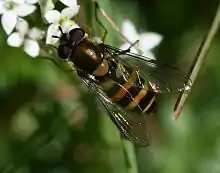Parasyrphus lineolus
Parasyrphus lineolus is a Holarctic species of hoverfly.[1][2]
| Parasyrphus lineolus | |
|---|---|
 | |
| male | |
 | |
| female | |
| Scientific classification | |
| Domain: | Eukaryota |
| Kingdom: | Animalia |
| Phylum: | Arthropoda |
| Class: | Insecta |
| Order: | Diptera |
| Family: | Syrphidae |
| Genus: | Parasyrphus |
| Species: | P. lineolus |
| Binomial name | |
| Parasyrphus lineolus (Zetterstedt, 1843) | |
| Synonyms[1] | |
| |
Description
External images
For terms see Morphology of Diptera
Wing length 7·25-8·25 mm. Black face stripe. Leg 3 black with at most knee yellow, apex of tibiae 3 black. Tarsi 1 all segments black. Pterostigma dark grey. The male genitalia are figured by Hippa (1968).[3] and Vockeroth (1969).[4] The Larva is described and figured by Heiss (1938) .[5]
See references for determination.[6][7][8][9]
Distribution
Palearctic Fennoscandia South to the Pyrenees. Ireland East through Central Europe and South Europe (North Italy and the Balkans), then East into European Russia and from the Urals through Siberia to the Pacific coast (Kamchatka, Sakhalin Is.) Nearctic Alaska to Quebec South to Colorado and New Mexico.[10][11]

Biology
Habitat: Abies, Picea, Pinus forest.[12] Flowers visited include yellow composites, white umbellifers, Acer platanoides, Achilea, Alchemilla, Anemone nemorosa, Calluna vulgaris, Caltha, Cardaminopsis, Galium, Inula, Meum, Petasites albus, Potentilla erecta, Prunus, Ranunculus, Rubus fruticosus, Salix, Sambucus nigra, Sorbus aucuparia, Taraxacum, Triplospermum inodorum, Valeriana officinalis, Veronica, Viburnum.[13] The flight period is April to July. The larva is aphid feeding.
References
- Chandler, Peter J. (1998). Checklists of Insects of the British Isles (New Series) Part 1: Diptera. Handbooks for the Identification of British Insects. Vol. 12. London: Royal Entomological Society of London. pp. 1–234. ISBN 0-901546-82-8.
- Stubbs, Alan E. & Falk, Steven J. (1983). British Hoverflies: An Illustrated Identification Guide. British Entomological & Natural History Society. pp. 253, xvpp.
- Hippa, H. (1968) A generic revision of the genus Syrphus and allied genera (Diptera: Syrphidae) in the Palearctic region, with descriptions of the male genitalia. Acta Ent.Fenn., 25: 1-94.
- Vockeroth J.R. (1969) A revision of the genera of the Syrphini (Diptera: Syrphidae). Memoirs of the Entomological Society of Canada 62: 1 –176.
- Heiss, E.M. (1938) A classification of the larvae and puparia of the Syrphidae of Illinois exclusive of aquatic forms. Univ.Illinois Bull. , 36: 1-142.
- Van Veen, M. (2004) Hoverflies of Northwest Europe: identification keys to the Syrphidae. 256pp. KNNV Publishing, Utrecht.addendum
- Van der Goot,V.S. (1981) De zweefvliegen van Noordwest - Europa en Europees Rusland, in het bijzonder van de Benelux. KNNV, Uitgave no.32: 275pp. Amsterdam.
- Bei-Bienko, G.Y. & Steyskal, G.C. (1988) Keys to the Insects of the European Part of the USSR, Volume V: Diptera and Siphonaptera, Part I. Amerind Publishing Co., New Delhi. ISBN 81-205-0080-6.
- Coe, R.L. (1953) Diptera: Syrphidae. Handbks.Ident. Br. insects, 10(1): 1-98. R. Ent. Soc. London. pdf
- Fauna Europaea
- Peck, L.V. (1988) Syrphidae. In: Soos, A. & Papp, L. (eds.) Catalogue of Palaearctic Diptera, 8: 11-230. Akad.Kiado, Budapest.
- Speight, M.C.D. (2011). "Species accounts of European Syrphidae (Diptera)" (PDF). Syrph the Net, the Database of European Syrphidae. 65: 285pp.
- de Buck, N. (1990) Bloembezoek en bestuivingsecologie van Zweefvliegen (Diptera, Syrphidae) in het bijzonder voor België. Doc. Trav. IRSNB, no.60, 1-167.